
U.S. Air Force Secretary Frank Kendall addresses the 48th Fighter Wing during a base-wide all-call at RAF Lakenheath, England on July 13 (U.S. Air Force Photo)
Whether and when the Lockheed Martin F-35 fighter will need a new Power and Thermal Management System (PTMS) or an upgrade has been a matter of debate within industry and the F-35 program.
Honeywell‘s Torrance, Calif. plant builds the F-35 PTMS, which supplies main engine start and auxiliary and emergency power needs, in addition to 30 Kilowatts of aircraft cooling.
“The PTMS is deeply integrated into the F-35’s overall design and systems architecture, seamlessly interacting with other critical components and subsystems,” according to Honeywell. “Preserving the PTMS avoids years of extensive highly complex re-engineering and re-testing efforts, thereby preventing costly delays that could arise from adopting an entirely different system.”
RTX‘s Collins Aerospace said at June’s Paris air show that the company had conducted a lab test in Windsor Locks, Conn., of the Enhanced Power and Cooling System (EPACS) that Collins Aerospace plans to offer as a replacement for the Honeywell PTMS (Defense Daily, June 28). Collins Aerospace said that EPACS will provide “more than twice the current cooling capability to support additional growth beyond Block 4 and is expected to provide enough cooling capacity for the life of the aircraft.”
EPACS includes a Collins Aerospace air cycle system, electric power generator and controller, and an auxiliary power unit by RTX’s Pratt & Whitney.
In May, a Government Accountability Office (GAO) report said that the F-35 will need a new or improved PTMS to accommodate future weapons and sensors on the aircraft (Defense Daily, May 30). The question appears to be when.
The U.S. Air Force decided this year to cancel the Advanced Engine Transition Program to develop and field a new, adaptive cycle engine on the F-35 and instead to move ahead with the Pratt & Whitney F135 Engine Core Upgrade (ECU).
Jill Albertelli, president of Pratt & Whitney’s military engine business, has said that “the F135 ECU paired with an upgraded PTMS can provide 80KW [kilowatts] or more of cooling power for the F-35, which will exceed all power and cooling needs for the F-35 through the life of the program.”

(Photo: Honeywell)
Honeywell said that it has been working with Lockheed Martin and the F-35 Joint Program Office to lend up to 17 kilowatts more of cooling for the F-35 for a total of 47 kilowatts of cooling on the Block 4 F-35.
From Honeywell’s standpoint, that may be enough extra cooling for the sensors and weapons on F-35 Block 4, while Block 5 after 2030 will likely require additional incremental changes like additive or other advanced heat exchangers to give the fighter 60 kilowatts to 80 kilowatts of cooling. The requirements for Block 4 and Block 5 thus far are not firm.
“When we look at swapping out a PTMS, let’s say you want to put in an EPACS, that’s like a $3 billion bill because you’ve got to replace all the spares, everything in the fleet, all the support equipment, all the training,” Matt Milas, president of Honeywell’s defense and space business, said in an Aug. 14 virtual interview. “We have four active depots that are supporting the PTMS worldwide. You’ve got specialized support equipment. We just activated a new test cell so there’s all these test requirements and capabilities that, if you switch, the government and the international partners are gonna have to pick up a very significant bill for not a whole lot of difference.”
This article was originally published by Defense Daily, a sister publication of Avionics International. It has been edited. Read the original version here >>